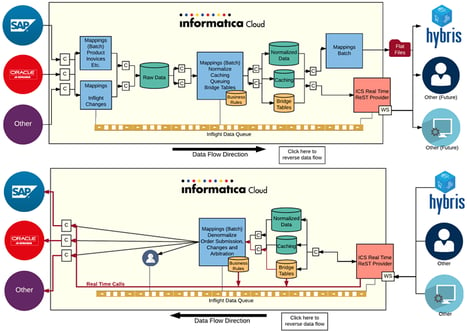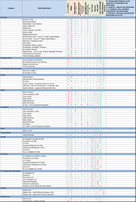
Case Study: ERP Real Time Integration
Written by Jared Hillam
Integrating Customer Experiences Despite Disparate ERPs
About Client
The Client makes, sells, and rents hospital beds and other patient-room furniture and equipment, along with stretchers, surgical tables and accessories, and other equipment for lifting and transporting patients. Because these products were attached to healthcare use cases, they also integrated with other electronic medical record solutions in the marketplace. Thus the Client is a highly integrated medical device manufacturer, and a global leader in its discipline.
About Intricity
Intricity is a team of specialized Data Management, Data Warehousing, and Business Intelligence experts. The team members at Intricity have been handpicked over the course of 20 years, and represent the top talent globally in Data oriented disciplines.
Challenge and Wins
Challenge
The Client leveraged SAP for their ERP, however after acquiring another major medical device manufacturer, they inherited a second massive JD Edwards implementation. They were faced with the decision of whether to fund a giant conversion effort into SAP or living with separate systems. The go forward decision ultimately landed with both SAP and JD Edwards working in parallel. However this decision also meant that the customer facing aspects of their business required legitimate integration. This was immediately evident during an SAP Hybris deployment which required an integrated view of product and service offerings. The service provider implementing SAP Hybris was delayed by almost a year in their delivery schedule, and a big impediment was the lack of data integration. To address this problem the Client began investigating software and service solution partners that could help them obtain productive integration.
Tooling
The Client ultimately decided to leverage Informatica’s solution stack to manage the integration of this data including:
-
- Informatica Cloud (ICS)
- Informatica Process Services
While the tools were chosen, they did not have a solution provider. After an extensive review of references and background the Client decided to engage Intricity to conduct the solution deployment.
Navigating Constraints
Data Latency
The deployment of SAP Hybris had varying levels of data access velocity which it required. For events which painted the SAP Hybris screen, the access had to be instantaneous. Others like the production of lists, could be driven with more structured queries. However, the requirements for each of these access velocities was something the joint teams had not explored in detail.
Bi-Directional Sync
The Hybris solution required the ability to read data from both SAP and JD Edwards and the ability to write back to SAP and JD Edwards. This mixed requirement along with the data latency requirements created a challenging scenario to architect.
Starting Behind the 8 Ball
The on-boarding of the data project had come as part of the SAP Hybris deployment which was already a year behind schedule. Thus Intricity would be playing catchup so that the data pipelines would be available as the Hybris deployment approached a testing phase. However, the first testing was needed on month 1 of a 4 month project, creating an immediate bottleneck.
Multiple Application Functions and Use Cases
The priority of the projects started in the Product, Order Entry, Order Status, B2B Pricing, Inventory and User Management categories. However, this was just the beginning of the required application functions which the Client wanted to deliver. Many other functions including the future deployments of international currencies and rental automation were required. Thus the platform needed to support an expansive number of application functions beyond the initial deployment.
Win 1: Test Data Generation for Hybris
Intricity worked with the Hybris Systems Integrator to generate a Hybris dummy data environment that the Hybris team could leverage ahead of the integration work being completed. This Pseudo environment allowed the Hybris consulting group to begin confirming their application behaviors with dummy data.
Win 2: Hybrid Latency Bi-Directional Architecture

The data access velocity challenges coupled with a bi-directional sync required a detailed architecture that explored each aspect of the application behaviors. The analysis of these systems resulted in two core architecture blueprints: one for the downstream delivery of data to SAP Hybris, and the other for the upstream recapture of record updates back into SAP and JD Edwards. The development of this architecture coupled with its awareness and consideration of the latency needs was a big win for the Client. Additionally it was a win for the SAP Hybris project which, up until this point, had no plan for dealing with the complex interactions of data between the two ERP systems.
Win 3: Integration of All the Critical Players

The integration of two large ERP systems, along with some other applications and multiple contractors, required detailed project management. Intricity managed a RACI (Responsible, Accountable, Consulted, and Informed) chart which all parties were actively held responsible for. This RACI enabled the team members to clearly understand the impact their role had on the project and surfaced gaps quickly.
Win 4: Reusable Data Elements Speeding Up Application Functions
Intricity rolled out the underlying data components as part of each application function which could be reused in other functional deployments. Thus as Inticity completed the Product and Order Entry integrations, the same data components could be used for Order Status, B2B Pricing, etc. This resulted in rapid wins as the roll out of each data feed to become progressively shorter. Ultimately the speed of deployment was so extensive that Intricity exceeded the speed of the SAP Hybris project.
Win 5: Integrated REST Components
The resulting bi-directional data interactions were delivered via a REST interface that could be used by the SAP Hybris team, but could also be leveraged in other domains as the Client deemed necessary. This provided a single location which web applications and other REST compliant tooling could communicate with the forked ERP back end.
Win 6: Integrated eCommerce and Other Applications
As the eCommerce deployment completed, the Client had a functional platform for customers to order/rent equipment which communicated with the relevant ERP functions and kept both ERPs in sync. Additionally, they had a data architecture which enabled the eCommerce platform and other applications to functionally grow. Since the successful deployment of the base components, additional components have been requested to enable other application functions.
To review the Intricity migration from Teradata to Snowflake in more detail reach out to specialist@intricity.com to review your specific use case. Or alternatively you can reach out to:
Who is Intricity?
Intricity is a specialized selection of over 100 Data Management Professionals, with offices located across the USA and Headquarters in New York City. Our team of experts has implemented in a variety of Industries including, Healthcare, Insurance, Manufacturing, Financial Services, Media, Pharmaceutical, Retail, and others. Intricity is uniquely positioned as a partner to the business that deeply understands what makes the data tick. This joint knowledge and acumen has positioned Intricity to beat out its Big 4 competitors time and time again. Intricity’s area of expertise spans the entirety of the information lifecycle. This means when you’re problem involves data; Intricity will be a trusted partner. Intricity's services cover a broad range of data-to-information engineering needs:
What Makes Intricity Different?
While Intricity conducts highly intricate and complex data management projects, Intricity is first a foremost a Business User Centric consulting company. Our internal slogan is to Simplify Complexity. This means that we take complex data management challenges and not only make them understandable to the business but also make them easier to operate. Intricity does this through using tools and techniques that are familiar to business people but adapted for IT content.
Thought Leadership
Intricity authors a highly sought after Data Management Video Series targeted towards Business Stakeholders at https://www.intricity.com/videos. These videos are used in universities across the world. Here is a small set of universities leveraging Intricity’s videos as a teaching tool:

Talk With a Specialist
If you would like to talk with an Intricity Specialist about your particular scenario, don’t hesitate to reach out to us. You can write us an email: specialist@intricity.com
(C) 2023 by Intricity, LLC
This content is the sole property of Intricity LLC. No reproduction can be made without Intricity's explicit consent.
Intricity, LLC. 244 Fifth Avenue Suite 2026 New York, NY 10001
Phone: 212.461.1100 • Fax: 212.461.1110 • Website: www.intricity.com

